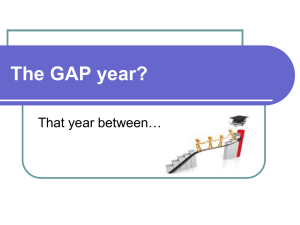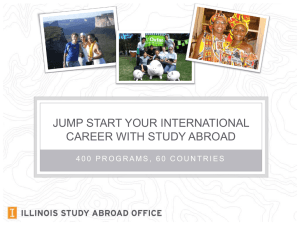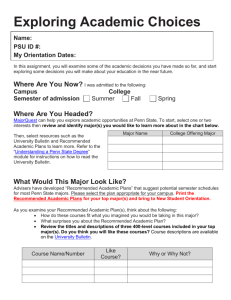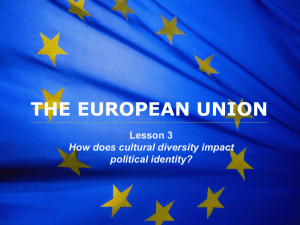docx - Penn State | Office of the President
advertisement
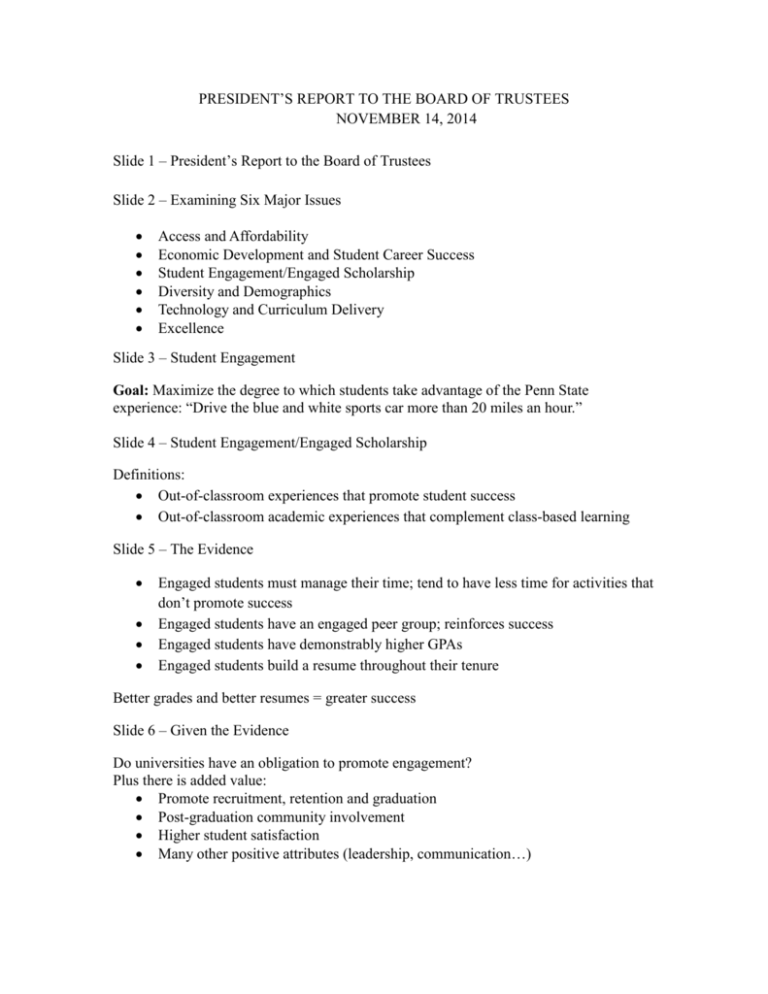
PRESIDENT’S REPORT TO THE BOARD OF TRUSTEES NOVEMBER 14, 2014 Slide 1 – President’s Report to the Board of Trustees Slide 2 – Examining Six Major Issues Access and Affordability Economic Development and Student Career Success Student Engagement/Engaged Scholarship Diversity and Demographics Technology and Curriculum Delivery Excellence Slide 3 – Student Engagement Goal: Maximize the degree to which students take advantage of the Penn State experience: “Drive the blue and white sports car more than 20 miles an hour.” Slide 4 – Student Engagement/Engaged Scholarship Definitions: Out-of-classroom experiences that promote student success Out-of-classroom academic experiences that complement class-based learning Slide 5 – The Evidence Engaged students must manage their time; tend to have less time for activities that don’t promote success Engaged students have an engaged peer group; reinforces success Engaged students have demonstrably higher GPAs Engaged students build a resume throughout their tenure Better grades and better resumes = greater success Slide 6 – Given the Evidence Do universities have an obligation to promote engagement? Plus there is added value: Promote recruitment, retention and graduation Post-graduation community involvement Higher student satisfaction Many other positive attributes (leadership, communication…) 2 Slide 7 – Engagement Areas: International Experiences Value: Worldview is essential (careers, perspective, culture) Status: Penn State is 19th in the U.S. for students studying abroad (approx. 2,500 students; 56 countries); Many active partnerships The chart in this slide shows the percentage of students studying abroad among the Big Ten Universities. Penn State falls in the middle of pack. Slide 8 – Engagement Areas: International Experiences The charts on this slide show the percentage of our students studying abroad, and money per student we spent on study abroad. As you can see, we are next to the bottom in the Big Ten. Obviously we are a big university. We can brag about the numbers of students that study abroad. On the other hand, if what we are really after is to maximize the number of students, the percentage of students, the breadth of students that can study abroad, this institution is not doing as well as it might be doing. Slide 9 – Engagement Areas: International Experiences Goal/Need/Issues: Lack of financial resources is a significant barrier to greater international engagement; cost is a factor in who can study abroad Address the challenge for degree candidates with highly structured course sequences Slide 10 – Engagement Areas: One-on-One Projects with Faculty Value: High correlation with completion of advanced degrees Deeper understanding; involvement end-to-end from design to conclusion including presentation Status: 28% students (UP) and 20% students (CC) are doing research/creative activities with faculty; based on survey data Average of 1,700 projects a year register for Research Topics Highly visible programs – e.g. Lunar Lion, EcoCAR 3 Slide 11 – Engagement Areas: One-on-One Projects with Faculty Status (continued) Central: Summer Discovery Grants – 60 at $3,000/year; many colleges add to award levels; create more opportunities Exhibition programs and conference travel for presentations Faculty can post opportunities centrally Low traffic through central office Slide 12 – Engagement Areas: One-on-One Projects with Faculty Status (continued) Colleges and Campuses: Highly decentralized efforts in specific fields (Science, Earth and Mineral Sciences, Engineering, Social Sciences) View: Universities with weaker programs are more decentralized Indications that there are insufficient opportunities Slide 13 – Engagement Areas: One-on-One Projects with Faculty Goals/Needs/Issues (University Faculty Senate report 2012) Increased number of higher paying, more competitive grants More faculty and student support More dedicated staff Higher visibility Greater efforts to include students in the arts and humanities Slide 14 – Engagement Areas: Leadership Value: Experiential, multiple perspectives, student career success, communication skills, self-confidence 4 Status: Opportunities are significant – 1,200 clubs and campus organizations; active student government Leadership conference at campus, regional and university-wide level (training, team-building, preparation) Leadership scholarships and student leadership awards Slide 15 – Engagement Areas: Leadership Status: Presidential Leadership Academy Office of Student Activities programs: Leaders Emerging Today, Student Leadership Practices Inventory; LeaderShape, Fall Leadership Program; Global Engagement and Leadership Experience Campus programs (experiential, retreats….) Leadership minor in Engineering and Agriculture Slide 16 – Engagement Areas: Leadership Goals/Needs/Issues: Already many great opportunities Perhaps expand within Penn State’s administrative areas (e.g. investment arena, administrative fellows) Slide 17 – Engagement Areas: Internships Value: Real world opportunity, networking, high correlation with employment offers Status: 52% of all undergraduates participate in at least one practical work assignment in industry, government or the university Slide 18 – Engagement Areas: Internships Central guidance: Check college first List of organizations Search strategies Some search capabilities 5 Colleges and Campuses Many with specific programs/lists Slide 19 – Engagement Areas: Internships Goal/Need/Issues: Potential development opportunity (?) ? Universities with weaker programs are more decentralized ? Indications that there are insufficient opportunities Slide 20 – Engagement Areas: Service and Service Learning Value: Community involvement, personal satisfaction, experiential, signal to potential employers Status: Highly visible programs: e.g. THON, the largest student-run philanthropy –$114 million raised since 1977 Numerous service learning and community-based research opportunities across Penn State, even international Minor in Civic and Community Engagement Slide 21 – Engagement Areas: Service and Service Learning Goal/Need/Issues: Seems impressive but difficult to assess –lack the knowledge of the level of involvement; breadth of opportunities; reach to the students Slide 22 – Strategies for Promoting Engagement Faculty Senate report: Provide every student with at least one, if not multiple, engaged scholarship experiences as undergraduates Create an inventory of designated courses/experiences Develop/invest in participation opportunities Invest in a clearly identified central entity Find new ways to reward faculty Create recognition and assessment mechanisms Slide 23 – Strategies for Promoting Engagement Strike an Engaged Scholar Medal 6 Define categories/expectations for each (e.g. complete 3 of 5 categories: international experiences; one-on-one experiences with faculty; leadership, internships, service) Expand opportunity if demand is present Need a way to count through a central entity Slide 24 – Goal Establish a vision where Penn State becomes a national leader in student engagement and realization of its benefits Ensure that these opportunities extend to all campuses and impact a growing number of students (all) Slide 25 – Address the Challenges Seek funding for international experiences and one-on-one research/creative experiences with faculty Develop engagement as a philanthropic focus Increase centralized functions and incentivize opportunities across our colleges and campuses in order to broaden opportunities for more students and leverage local resources Promote the visibility of the tremendous amount of activity already occurring at Penn State Increase the opportunities for recognition and reward Slide 26 – End Note High value –put the blue and white sports car through its paces Healthier, happier, better grades, better resume, better career opportunities Added value in retention, graduation, critical thinking Need to implement best strategies for engagement Slide 27 – Questions?
